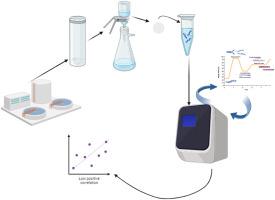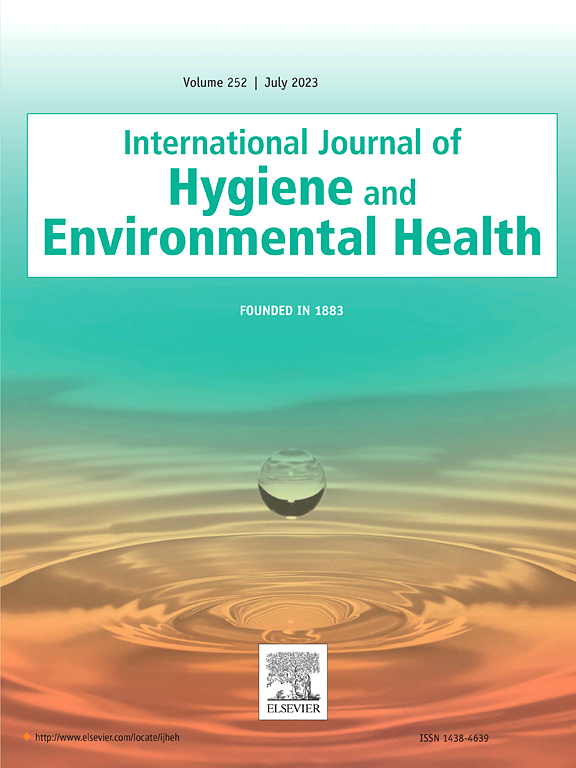Wastewater surveillance of Candida auris in Baltimore
IF 4.5
2区 医学
Q1 INFECTIOUS DISEASES
International journal of hygiene and environmental health
Pub Date : 2024-11-20
DOI:10.1016/j.ijheh.2024.114486
引用次数: 0
Abstract
Candida auris (C. auris), an opportunistic fungus causing disease, poses a growing global health concern due to its significant mortality rate, resistance to antifungal treatment, and ability to persist in healthcare settings. Over a span of 47 weeks, untreated wastewater samples were regularly gathered from two wastewater treatment plants (referred to as WWTP-A and WWTP-B) in Baltimore, from July 27, 2022, to June 23, 2023. Throughout the study period, 110 primary influent (PI) samples were collected from both WWTP-A and WWTP-B. A quantitative polymerase chain reaction (qPCR) method was used to analyze C. auris captured on filters (0.45 μm) from these samples. Positive C. auris detection (11.81%) occurred in the influent samples, with a higher frequency of detection in WWTP-B. Influent wastewater concentrations ranged from 1.2 to 7.9 log10 gene copies per liter (gc/L). Interestingly, seasonal analysis showed that C. auris presence in wastewater was more pronounced during the spring season, indicating a sustained existence of the pathogen as seasons changed. Integration of wastewater surveillance and clinical data reveals temporal correlations in C. auris dynamics. The resulting Pearson correlation coefficient of 0.27 reveals a weak positive correlation between the number of new C. auris cases in Baltimore and the quantity of detected gene copies in wastewater. This study marks the first instance of detecting C. auris in Baltimore's wastewater. The results emphasize that wastewater monitoring could serve as an additional early warning tool for anticipating and managing future outbreaks of C. auris.

巴尔的摩念珠菌废水监测。
白色念珠菌(C. auris)是一种机会性致病真菌,由于其致死率高、对抗真菌治疗具有抗药性以及能够在医疗环境中持续存在,它已成为一个日益严重的全球健康问题。在 2022 年 7 月 27 日至 2023 年 6 月 23 日的 47 周时间里,巴尔的摩的两家污水处理厂(分别称为 WWTP-A 和 WWTP-B)定期收集未经处理的废水样本。在整个研究期间,从污水处理厂-A 和污水处理厂-B 收集了 110 份一次进水 (PI) 样本。采用定量聚合酶链式反应 (qPCR) 方法分析从这些样本的过滤器(0.45 μm)上捕获的 C. auris。在进水样本中检测到阳性的 C. auris(11.81%),在污水处理厂 B 中检测到的频率较高。进水废水的浓度范围为 1.2 至 7.9 log10 基因拷贝/升(gc/L)。有趣的是,季节性分析表明,废水中的阿氏杆菌在春季更为明显,这表明随着季节的变化,病原体会持续存在。废水监测与临床数据的整合揭示了 C. auris 动态的时间相关性。由此得出的皮尔逊相关系数为 0.27,表明巴尔的摩市新发现的阿氏杆菌病例数与废水中检测到的基因拷贝数之间存在微弱的正相关关系。这项研究标志着首次在巴尔的摩的废水中检测到 C. auris。研究结果表明,废水监测可作为一种额外的预警工具,用于预测和管理未来爆发的阿氏杆菌疫情。
本文章由计算机程序翻译,如有差异,请以英文原文为准。
求助全文
约1分钟内获得全文
求助全文
来源期刊
CiteScore
11.50
自引率
5.00%
发文量
151
审稿时长
22 days
期刊介绍:
The International Journal of Hygiene and Environmental Health serves as a multidisciplinary forum for original reports on exposure assessment and the reactions to and consequences of human exposure to the biological, chemical, and physical environment. Research reports, short communications, reviews, scientific comments, technical notes, and editorials will be peer-reviewed before acceptance for publication. Priority will be given to articles on epidemiological aspects of environmental toxicology, health risk assessments, susceptible (sub) populations, sanitation and clean water, human biomonitoring, environmental medicine, and public health aspects of exposure-related outcomes.

 求助内容:
求助内容: 应助结果提醒方式:
应助结果提醒方式:


